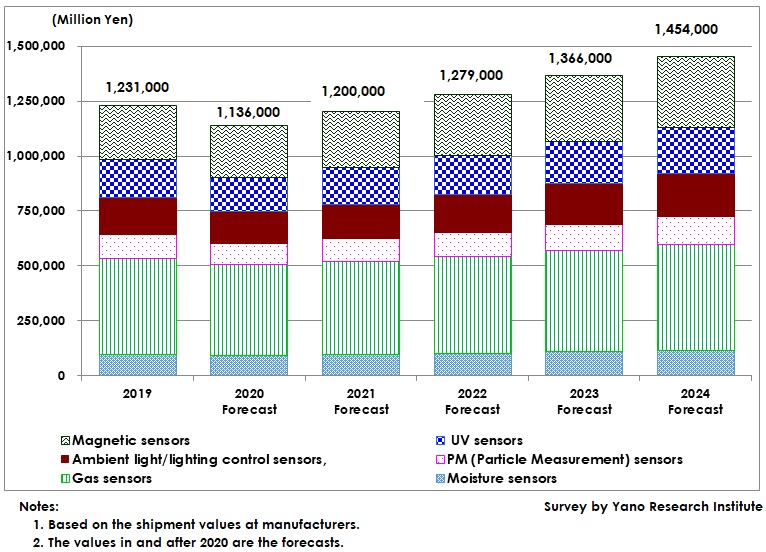No.2613
Global Market of Industrial Sensors (Environmental Sensing): Key Research Findings 2020
Global Market Size Forecast of Industrial Sensors (Environmental Sensing) Attains 1,454,000 Million Yen by 2024
Yano Research Institute (the President, Takashi Mizukoshi) carried out a survey on the global industrial sensor market (relating to environmental sensing) and found out the trends by type, the trends of market players, and the future outlook.

Market Overview
In recent years, the attention has been increasingly paid to environmental sensing in the course of tackling the environmental issues, advancement of IoT technologies, and improved performance of industrial equipment, which has been driving the demand for industrial sensors. Among all industrial sensors, this research has targeted six types of sensors that mainly measure environmental indicators. The global market size of industrial sensors (relating to environmental sensing) for 2020, based on the shipment values at manufacturers, is forecasted to be 1,136,000 million yen, 92.3% of the size of the previous year.
When observing the market share by type, gas sensors occupy the largest at 35% (based on the shipment value in 2020,) followed by magnetic sensors accounting for about 20%, which are followed by these sensors in the order of UV sensors, ambient light/lighting control sensors, PM (Particle Measurement) sensors, and moisture sensors.
Noteworthy Topics
Trend of Automotive Magnetic Sensors
In recent years, automotive sensors have been increasingly installed, as the average number of sensors embedded per automobile has attained about 75 (excluding hall-effect sensors for brushless dc motors) by 2019, including a reed switch, even for those automobiles affordable for wide range of people. Among such sensors, more than 50% are regarded to be magnetic sensors. When hall-effect sensors for brushless dc motors are included, the number of magnetic sensors embedded per automobile can be more than 60 units.
A large part of automotive magnetic sensors are comprised of hall-effect sensors which occupy the largest even when converting into monetary value i.e. 59.2% or about 61,000 million yen, followed by MR-based sensors accounting for 26.2% or 27,000 million yen, reed switches accounting for 10.7% or 11,000 million yen, and fluxgate sensors accounting for 3.9% or 4,000 million yen.
Hereafter, while MR-based sensors are projected to gradually increase the market share, magnetic sensors continue to play an important role in the situation where vehicles are increasingly electrified, for all the types of magnetic sensors except for reed switches are contactless and durable.
Future Outlook
The global market size of industrial sensors (relating to environmental sensing) based on the shipment values at manufacturers is forecasted to achieve 1,454,000 million yen by 2024, as the society become more conscious of environmental issues which expands the demand for environmental sensing, in addition to advancement in IoT technologies and increased performance of industrial and automotive equipment. Although the market has already exceeding 1 trillion yen, the CAGR (compound annual growth rate) from 2019 to 2024 is expected to be 3.4%.
When observing this by type, CAGR of magnetic sensors, which marks the largest growth rate, is projected to attain 5.6% from 2019 to 2024. The gas sensor market is expected to shift to a new phase from around 2023, as there are diverse new products to emerge in order to respond to the demand for increasing accuracy for industrial or automotive sensors.
On the other hand, the lowest CAGR from 2019 to 2024 is attained by gas sensors with 2.0%. However, the market size of gas sensors is the largest among the six markets, exceeding 400,000 million yen. In addition, because of the influence of Paris Agreement (on climate change) in 2016 in which a goal has set for the global warming gases to be reduced to 40% of that in 1990 by 2030, the demand for watching CO2 grew at almost every factory, expanding the demand for CO2 sensors worldwide. Also, in the status where exhaust gas regulation has been ever stricter for automotive sensors, the demand for oxygen sensors and nitrogen oxides (NOx) sensors have become enormous for reducing emission of nitrogen oxides (NOx) which represents environment-polluting gas, forming a large market.
Research Outline
2.Research Object: Companies manufacturing, selling, or distributing industrial sensors (environmental sensors) and the R&D institutions
3.Research Methogology: Face-to-face interviews by our expert researchers, and literature research
The Industrial Sensor (Environmental Sensing) Market
The industrial sensor market (relating to environmental sensing) in this research refers to the market of those sensors that mainly measure environmental indicators among all the industrial sensors, which include the following six types of sensors: Moisture sensors, gas sensors, PM (Particle Measurement) sensors, ambient light/lighting control sensors, UV sensors, and magnetic sensors. The market size was calculated based on the shipment values at manufacturers.
<Products and Services in the Market>
1) Moisture sensors, 2) gas sensors, 3) PM (Particle Measurement) sensors, 4) ambient light/lighting control sensors, 5) UV sensors, and 6) magnetic sensors
Published Report
Contact Us
The copyright and all other rights pertaining to this report belong to Yano Research Institute.
Please contact our PR team when quoting the report contents for the purpose other than media coverage.
Depending on the purpose of using our report, we may ask you to present your sentences for confirmation beforehand.